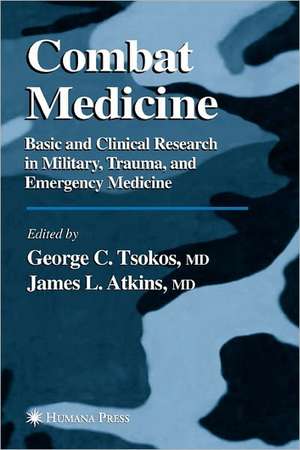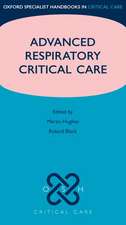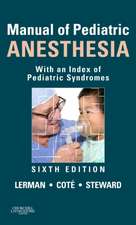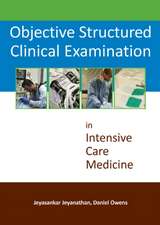Combat Medicine: Basic and Clinical Research in Military, Trauma, and Emergency Medicine
Editat de George C. Tsokos, James L. Atkinsen Limba Engleză Paperback – 5 noi 2010
| Toate formatele și edițiile | Preț | Express |
|---|---|---|
| Paperback (1) | 1394.73 lei 6-8 săpt. | |
| Humana Press Inc. – 5 noi 2010 | 1394.73 lei 6-8 săpt. | |
| Hardback (1) | 1404.43 lei 6-8 săpt. | |
| Humana Press Inc. – 14 iul 2003 | 1404.43 lei 6-8 săpt. |
Preț: 1394.73 lei
Preț vechi: 1468.13 lei
-5% Nou
Puncte Express: 2092
Preț estimativ în valută:
267.05€ • 278.08$ • 221.57£
267.05€ • 278.08$ • 221.57£
Carte tipărită la comandă
Livrare economică 14-28 februarie
Preluare comenzi: 021 569.72.76
Specificații
ISBN-13: 9781617373374
ISBN-10: 1617373370
Pagini: 440
Ilustrații: XI, 426 p. 40 illus.
Dimensiuni: 152 x 229 x 23 mm
Greutate: 0.64 kg
Ediția:Softcover reprint of hardcover 1st ed. 2003
Editura: Humana Press Inc.
Colecția Humana
Locul publicării:Totowa, NJ, United States
ISBN-10: 1617373370
Pagini: 440
Ilustrații: XI, 426 p. 40 illus.
Dimensiuni: 152 x 229 x 23 mm
Greutate: 0.64 kg
Ediția:Softcover reprint of hardcover 1st ed. 2003
Editura: Humana Press Inc.
Colecția Humana
Locul publicării:Totowa, NJ, United States
Public țintă
Professional/practitionerCuprins
I Basic Mechanisms.- 1 Apoptosis.- 2 Nitric Oxide.- 3 The Microcirculation and Adhesion Molecules.- 4 Heat Stress.- 5 Immune System.- 6 Complement Inhibitors in Trauma.- 7 Infections.- II Current Concepts.- 8 Hemorrhagic Shock and Resuscitation: Trauma Research at the Trauma Research and Readiness Institute for Surgery.- 9 Ischemia/Reperfusion Injury.- 10 Acute Respiratory Distress Syndrome.- 11 Thermal Injury.- 12 Inhalation Injury.- 13 Traumatic Brain Injury.- 14 Red Blood Cell Storage.- 15 Bioterrorism.
Recenzii
"...reflects a modern approach to medical planning for war...a concise manual for those researching organ injury following trauma, toxic or infectious assaults." - British Journal of Surgery
Textul de pe ultima copertă
The events of September 11, 2001 have clearly demonstrated that the future pathologies of warfare will increasingly affect noncombatant populations on a large scale and require new levels of treatment expertise. In Combat Medicine: Basic and Clinical Research in Military, Trauma, and Emergency Medicine, highly accomplished clinical and basic investigators concisely review the leading research issues confronting emergency and military medicine today. These experts begin by presenting the latest thinking about the molecular and cellular mechanisms of trauma-apoptosis, abnormalities in nitric oxide production, complement activation, and immune cell response to stressors-that lead to tissue damage, and then describe cutting-edge research aimed at understanding and reversing the consequent damage to major organs. The clinical conditions covered include hemorrhagic shock and resuscitation, ischemia-reperfusion injury, acute respiratory distress syndrome, thermal injury, inhalation injury, and traumatic brain injury. The authors discuss the natures of combat pathologies, current research, emerging treatments, red blood cell storage, and bioterrorism involving anthrax, smallpox, plague, and other infectious and toxic agents.
Cutting-edge and timely, Combat Medicine: Basic and Clinical Research in Military, Trauma, and Emergency Medicine offers not only clinical and basic investigators, but also surgical and medical residents, a concise introduction to the principal clinical conditions encountered in emergency, disaster, and combat medicine, as well as an up-to-date statement of where our diagnostic and treatment programs now stand, and what we still need to learn for future preparedness.
Cutting-edge and timely, Combat Medicine: Basic and Clinical Research in Military, Trauma, and Emergency Medicine offers not only clinical and basic investigators, but also surgical and medical residents, a concise introduction to the principal clinical conditions encountered in emergency, disaster, and combat medicine, as well as an up-to-date statement of where our diagnostic and treatment programs now stand, and what we still need to learn for future preparedness.
Caracteristici
Includes supplementary material: sn.pub/extras







